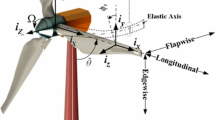Abstract
In the present paper, the torsional–translational response of a prototype wind turbine tower considered as an irregular structure is studied. As a matter of fact, a plethora of wind turbine towers has collapsed during the last decades due to torsional dynamic actions. An effective numerical model of the prototype irregular wind turbine tower is herein developed which has been verified by the application of the continuous model method considering both a fully fixed and a partially fixed foundation. As known, the higher eigenmodes of the tower strongly affect the structural response and may become critical in the case that the tower is subjected to strong dynamic loading, as is, e.g., wind loading, when simultaneously excited by a strong seismic motion. In order to estimate the role of the fundamental torsional modes of the above-mentioned structure in its overall structural response, three pairs of appropriately selected artificial seismic accelerograms having response acceleration spectra (for equivalent viscous damping ratio 0.03) equivalent to the Eurocode elastic acceleration spectra are used and then, applying a type of backwards analysis, an equivalent dynamic or static torsion loading is defined.
Similar content being viewed by others
References
Ragheb, M.: Safety of Wind Systems. http://www.windfarmaction.files.wordpress.com/2011/10/safety-of-wind-.systems.pdf (2014). Accessed 5 Jan 2015
Chaviaropoulos P.K.: Flap/lead-lag aeroelastic stability of wind turbine blade sections. Wind Energy 2, 99–112 (1999)
Riziotis V.A., Voutsinas S.G.: Fatigue Loads on Wind Turbines of different control strategies operating in complex terrain. J. Wind Eng. Ind. Aerodyn. 85(3), 211–240 (2000)
Hansen M.H.: Aeroelastic stability analysis of wind turbines using an eigenvalue approach. Wind Energy 7, 133–143 (2004)
Holierhoek, J.: Aeroelasticity of Large Wind Turbines. Ph. D. Thesis, TU Delft, Delft (2008)
Baniotopoulos C.C., Borri C., Stathopoulos T.: Environmental Wind Engineering and Design of Wind Energy Structures. Springer Wien, New York (2011)
Gasch R., Twele J.: Wind Energy Plants. Springer, Heidelberg (2012)
Lavassas I., Nikolaidis G., Zervas P., Efthimiou E., Doudoumis I., Baniotopoulos C.C.: Analysis and design of the prototype of an 1 MW steel wind turbine tower. Eng. Struct. 25(8), 1097–1106 (2003)
Baniotopoulos, C.C.; Lavasas, I.; Nikolaidis, G.; Zervas, P.; Efthimiou, E.; Doudoumis, I.: On the design of the prototype of wind turbine towers. In: Proceedings of COST C14 International Conference on the Impact of Wind and Storm on City Life and Built Environment, Brussels, Belgium, 5–7 May, pp. 7.1–10 (2004)
Makarios T., Baniotopoulos C.C.: Wind energy structures: modal analysis by the continuous model approach. J. Vib. Control 20(3), 395–405 (2014)
Makarios T., Baniotopoulos C.C.: Modal analysis of wind turbine tower via its continuous model with partially fixed foundation. Int. J. Innov. Res. Adv. Eng. 2(1), 14–25 (2015)
Stavroulakis, G.E.; Foutsitzi, G.; Hadjigeorgiou, E.; Marinova, D.G.; Zacharenakis, E.C.; Baniotopoulos, C.C.: Numerical experiments on smart beams and plates. In: Proceedings of Smart 2006 Conference, Rome, pp. 218–236 (2006)
Moutsopoulou, A.; Pouliezos, A.; Stavroulakis, G.E.: Simulation and modelling using robust control of wind induced vibration on smart beams. In Proceedings of COMPDYN 2009—2nd International Conference on Computational Methods in Structural Dynamics and Earthquake Engineering, Rhodos, Greece, 22–24 June, pp. 582–594 (2009)
Kessentini S., Choura S., Najar F., Franchek M.A.: Modeling and dynamics of a horizontal axis wind turbine. J. Vib. Control 16(13), 2001–2021 (2010)
Bayraktar A., Altunişik A., Sevim B., Türker T.: Seismic response of a historical masonry minaret using a finite element model updated with operational modal testing. J. Vib. Control 17(1), 129–149 (2011)
Aly, A.M.: Influence of turbulence, orientation, and site configuration on the response of buildings to extreme wind. Sci. World J. 2014, 15 (2014). doi:10.1155/2014/178465
Aly A.M.: Pressure Integration Technique for Predicting Wind-Induced Response in High-Rise Buildings. Alexandria Engineering Journal, Elsevier 52(4), 717–731 (2013)
Rosa L., Tomasini G., Zasso A., Aly A.M.: Wind-induced dynamics and loads in a prismatic slender building: modal approach based on unsteady pressure measures. J. Wind Eng. Ind. Aerodyn. 107–108, 118–130 (2012)
Makarios, T.; Baniotopoulos, C.C.: Torsional–translational behavior of irregular wind energy structures. In Proceedings of Advances in Structural Engineering and Mechanics (ASEM13), September 8–12, Jeju, Korea, pp. 1741–1751 (2013)
Beer E.P., Johnston E.R. Jr: Mechanics of Materials, 2nd edn. McGraw Hill, New York (1992)
CEN-European Committee for Standardization: EN 1998-1 Eurocode 8-Design of structures for earthquake resistance—Part 1: General rules, seismic actions and rules for buildings. European Committee for Standardization, Brussels (2004)
Makarios T.: Evaluating of the effective seismic amplification factor on a probabilistic basis. Struct. Eng. Mech. 42(1), 121–129 (2012)
Makarios T.: Peak ground acceleration functions of mean return period for known reliability index of hellenic design earthquakes. J. Earthq. Eng. 17(1), 98–109 (2013)
Makarios T.: Design characteristic value of the arias intensity magnitude for artificial accelerograms compatible with Hellenic seismic hazard zones. Int. J. Innov. Res. Adv. Eng. 2(1), 87–98 (2015)
SAP2000 Advanced 16.0.0: Structural Analysis Program. Computers and Structures Inc. http://www.csiamerica.com/ (2013)
Author information
Authors and Affiliations
Corresponding author
Rights and permissions
About this article
Cite this article
Makarios, T.K., Efthymiou, E. & Baniotopoulos, C.C. On the Torsional–Translational Response of Wind Turbine Structures. Arab J Sci Eng 41, 1241–1249 (2016). https://doi.org/10.1007/s13369-015-1911-7
Received:
Accepted:
Published:
Issue Date:
DOI: https://doi.org/10.1007/s13369-015-1911-7




